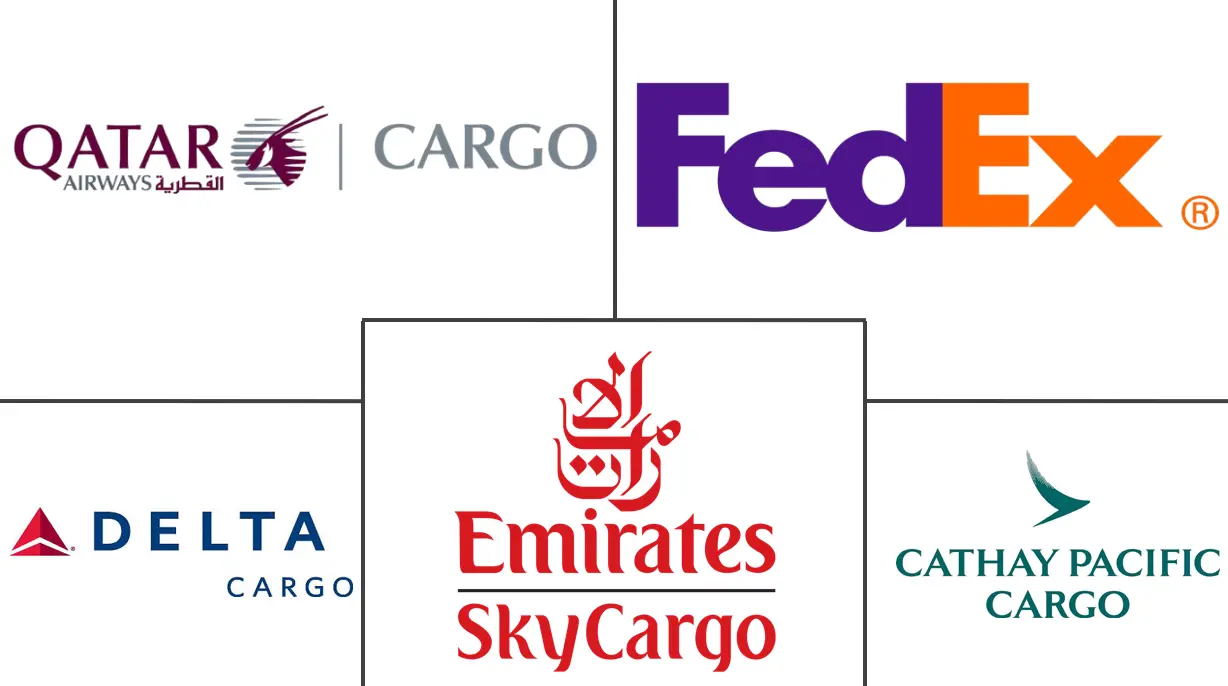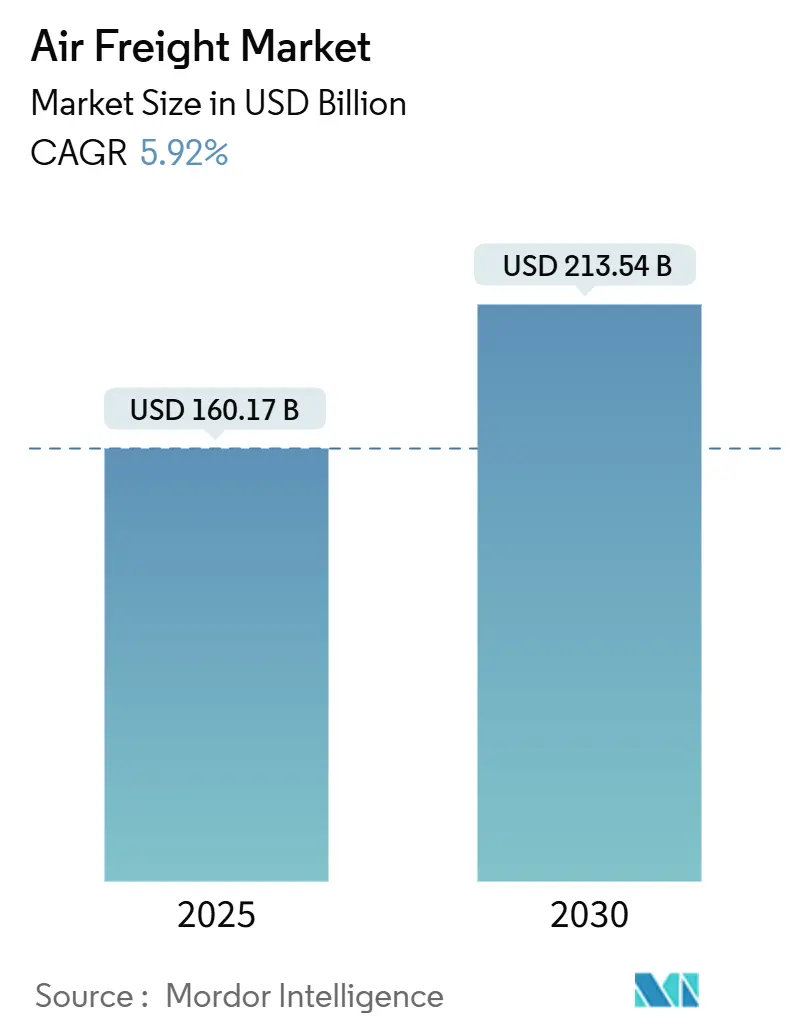
Air Freight Market Analysis by Mordor Intelligence
The Air Freight Market size is estimated at USD 160.17 billion in 2025, and is expected to reach USD 213.54 billion by 2030, at a CAGR of 5.92% during the forecast period (2025-2030).
Rising cross-border e-commerce volumes, ongoing supply-chain reconfiguration, and pharmaceutical cold-chain needs are the primary forces behind this expansion. Airlines are rebalancing capacity toward specialized cargo, while passenger-to-freighter conversions support additional lift. Regulatory momentum on sustainable aviation fuel and dynamic pricing adoption is reshaping cost structures, yet overall demand remains resilient. Consolidation among forwarders and integrators indicates that scale, network depth, and technology are critical to sustaining competitive advantage in the air freight market.
Key Report Takeaways
- By service, Freight Transport captured 5.10% CAGR growth through 2030, while Freight Forwarding held 45% of the 2024 air freight market size.
- By destination, Domestic traffic is projected at 5.50% CAGR to 2030, although International service controlled 84% of 2024 volume within the air freight market.
- By cargo type, Special Cargo is increasing at a 4.80% CAGR to 2030, whereas General Cargo held 63% of the 2024 air freight market size.
- By end-user, Manufacturing & Automotive owned 29% of the air freight market share in 2024, but E-commerce & Retail shows a 5.30% CAGR to 2030.
- By geography, Asia-Pacific accounted for a 41% air freight market share in 2024 and is advancing at a 5.80% CAGR through 2030.
Global Air Freight Market Trends and Insights
Drivers Impact Analysis
| Driver | (~) % Impact on CAGR Forecast | Geographic Relevance | Impact Timeline |
|---|---|---|---|
| Expanding cross-border e-commerce shipments | +1.8% | Global, with concentration in Asia-Pacific to North America corridors | Medium term (2-4 years) |
| Accelerated supply-chain needs for high-tech electronics | +1.2% | Asia-Pacific core, spill-over to North America & Europe | Short term (≤ 2 years) |
| Global pharmaceutical cold-chain demand | +0.9% | Global, with emphasis on temperature-controlled routes | Long term (≥ 4 years) |
| Resumption of trade & near-shoring urgency | +1.1% | North America & Latin America, secondary impact in Europe | Medium term (2-4 years) |
| Cargo-dedicated narrow-body conversions | +0.7% | Global, with focus on intra-regional routes | Medium term (2-4 years) |
| AI-driven dynamic pricing adoption | +0.5% | Global, led by major carriers in developed markets | Long term (≥ 4 years) |
| Source: Mordor Intelligence | |||
Expanding Cross-Border E-Commerce Shipments
Cross-border online retail is accelerating smaller, more frequent shipments that favor air freight’s speed advantage. Airlines are reconfiguring belly capacity and scheduling extra freighter frequencies to support marketplaces that promise three-to-five-day delivery. New trans-Pacific routes connecting production zones in Asia with fulfillment centers in Mexico and the United States have emerged, deepening network density and boosting load factors. Streamlined customs processes and electronic documentation shorten clearance times, protecting service reliability. Continuous retail promotion cycles create highly volatile but generally upward-trending demand that underpins the growth of the air freight market[1]Boeing Company, “World Air Cargo Forecast,” boeing.com.
Accelerated Supply-Chain Needs for High-Tech Electronics
Semiconductor producers in Southeast Asia and Mexico now fly critical components to final assembly lines to support just-in-time manufacturing. Payloads often contain high-value microchips whose weight-to-value ratio justifies premium air charges. Airlines have introduced specialized handling protocols that mitigate static, vibration, and humidity risks, protecting product integrity. Near-shoring from China to Mexico creates shorter, higher-frequency lanes that reshape hub structures and favor narrow-body aircraft conversions. These dynamics reinforce the strategic role of the air freight market in electronics supply continuity[2]Emirates SkyCargo, “Emirates SkyCargo Orders 5 Boeing 777Fs,” skycargo.com.
Global Pharmaceutical Cold-Chain Demand
Personalized medicines, biologics, and vaccines require strict 2 °C-8 °C temperature ranges throughout transit. Carriers certified under IATA’s CEIV Pharma scheme invest in thermal blankets, active containers, and real-time monitoring that command premium yields. Regulatory oversight by the U.S. FDA and the European Medicines Agency enforces traceability, fostering long-term contractual relationships with shippers. The steady nature of health-care demand cushions revenue cycles, providing a predictable base load for freighter operations and strengthening the outlook for the air freight market[3]Japan Airlines, “International Fare Fuel Surcharge,” jal.co.jp.
Resumption of Trade & Near-Shoring Urgency
North American brands moving production closer to end markets now rely on U.S.–Mexico air corridors to move intermediate goods quickly. Bidirectional flows support balanced aircraft utilization, which reduces repositioning costs. Mexican investment incentives and logistics-friendly regulations amplify hub development at airports such as Querétaro and Monterrey. These routes shorten transit times versus Asia and underpin the domestic leg of regional supply chains, thus enlarging the customer base for the air freight market.
Restraints Impact Analysis
| Restraint | (~) % Impact on CAGR Forecast | Geographic Relevance | Impact Timeline |
|---|---|---|---|
| Volatile fuel prices & surcharges | -1.4% | Global, with higher impact on long-haul routes | Short term (≤ 2 years) |
| Aviation-emission regulations | -0.8% | Europe & North America, expanding globally | Long term (≥ 4 years) |
| Airport slot constraints at secondary hubs | -0.6% | North America & Europe, emerging in Asia-Pacific | Medium term (2-4 years) |
| Shortage of certified ground-handling labour | -0.7% | Global, acute in developed markets | Medium term (2-4 years) |
| Source: Mordor Intelligence | |||
Volatile Fuel Prices & Surcharges
Jet fuel accounts for more than 25% of operating costs. Airlines publish monthly surcharge tables pegged to spot kerosene prices, transferring volatility to shippers. Sustainable aviation fuel blends, mandated in the EU from 2025, cost two to three times traditional Jet-A-1 and add further upward pressure. Some carriers introduce route-specific “green” fees to recover incremental expenses, which can erode price-sensitive demand. Effective fuel hedging and energy-efficient fleet renewal are vital to protecting margins in the air freight market[4]Deutsche Lufthansa AG, “Environmental Surcharge FAQ,” lufthansa.com.
Aviation-Emission Regulations
CORSIA, the EU Emissions Trading System, and national net-zero pledges compel carriers to cap or offset carbon output. Operators of older freighters face higher compliance costs, accelerating retirements, and tightening capacity. Investments in new-generation freighters with 20% lower fuel burn mitigate cost exposure but require substantial capital. Sustainability surcharges raise shipper prices, potentially diverting low-yield cargo to ocean transport and dampening certain routes within the air freight market.
Segment Analysis
By Service: Forwarding Influence Amid Transport Momentum
Freight Forwarding 45% of 2024 revenue, reflecting complex multi-modal coordination needs, though its growth pace lags the broader air freight market at 3.8%. Many forwarders now offer digital booking portals and customs engines that deepen client retention. The Freight Transport sub-segment, covering dedicated cargo flights and courier-express-parcel lift, is growing at a 5.10% CAGR, outpacing forwarding as shippers seek direct carrier relationships. Market entrants leveraging asset-light virtual airlines and block-space agreements chip away at incumbent share, yet full-service forwarders maintain relevance through value-added visibility and insurance.
Digitalization blurs historic boundaries: integrated carriers expand brokerage desks, while forwarders charter freighters during capacity crunches. Larger shippers demand end-to-end control, pushing providers toward vertical integration. These shifts encourage competitive differentiation in technology, network reach, and specialized handling that underpins the sustained expansion of the air freight market.
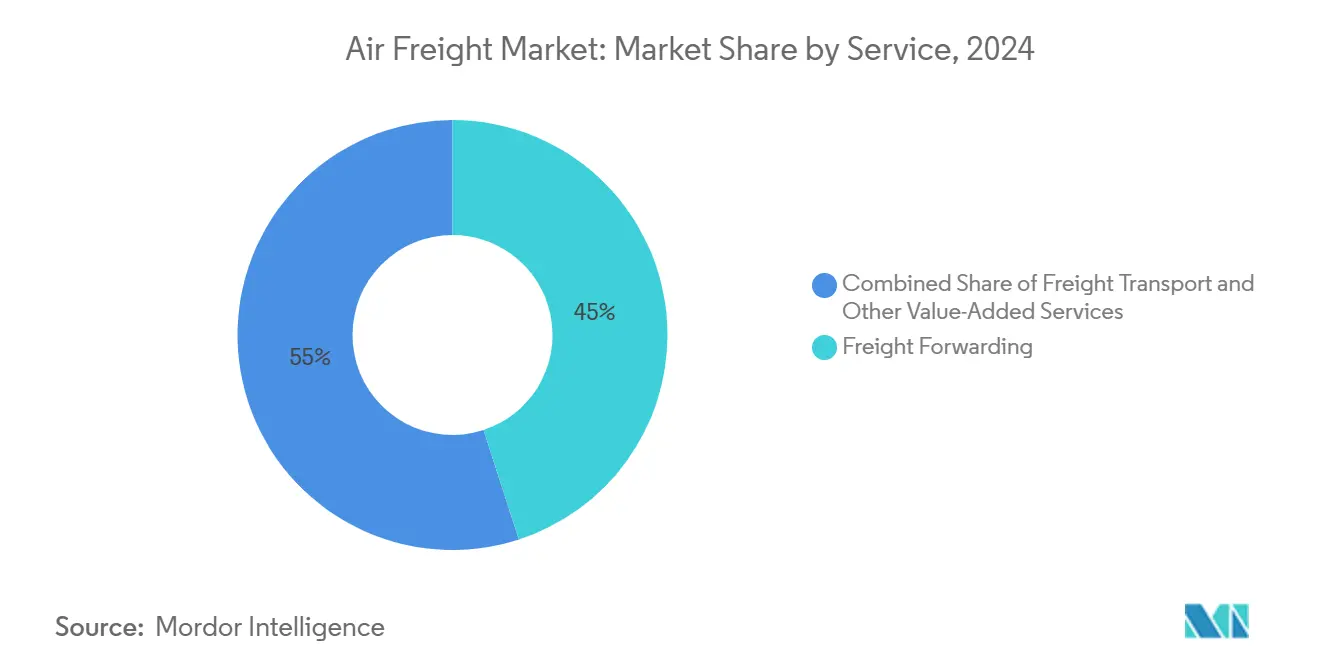
Note: Segment shares of all individual segments available upon report purchase
By Destination: International Scale versus Domestic Velocity
International traffic represented 84% of 2024 tonnage, benefiting from global trade flows and wide-body aircraft economics. Long-haul lanes from Asia-Pacific to North America and Europe generate high load factors and premium yields. However, domestic air freight’s 5.50% CAGR exceeds international growth as regionalization drives short-haul replenishment between near-shored factories and consumption centers. E-commerce same-day and next-day promises accelerate dedicated domestic freighter networks, particularly in China, India, and the United States.
Regulatory simplicity, predictable schedules, and rising express parcel penetration support domestic lanes. Airlines redeploy older narrow-body conversions to shuttle goods between secondary cities, improving aircraft utilization. The complementary nature of these flows supports balanced fleet strategies and cushions macro-volatility, reinforcing the broad-based health of the air freight market.
By Carrier Type: Freighter Dominance with Belly Resurgence
Freighter aircraft delivered 56% of 2024 lift and remain indispensable for oversized, hazardous, or temperature-controlled cargo. Operators value main-deck loading flexibility and route independence from passenger schedules. Yet as global RPKs recover, belly capacity expands, leading to a 4.30% CAGR for this segment through 2030. Network airlines monetize spare hold space via sophisticated revenue-management tools that integrate passenger and cargo yields, raising overall profitability.
Passenger-to-freighter conversions provide cost-effective lift tailored to e-commerce density on mid-haul routes. Over 50% of projected freighter demand until 2043 stems from such conversions, especially A321-P2F and 737-800BCF variants. Balancing pure-cargo fleets with belly networks diversifies risk, sustaining route economics across the air freight market.
By Cargo Type: General Volume Meets Special Premium
General Cargo, comprising consumer goods and industrial parts, still accounts for 63% of tonnage, though its growth trails niche segments. Rate competition is intense, and modal shift to ocean or rail occurs when yields spike. Special Cargo—pharmaceuticals, high-tech, perishables, and dangerous goods—advances at 4.80% CAGR, commanding rates 1.5-2.5 times higher than general. Investments in CEIV certification, dedicated cool-chains, and lithium-battery safe rooms differentiate carriers and yield sticky contracts.
Tighter regulations, such as IATA DGR updates on battery handling, raise compliance costs but strengthen entry barriers. Specialized infrastructure and skilled staff improve quality assurance, enhancing carrier reputation and elevating overall service standards in the air freight market.
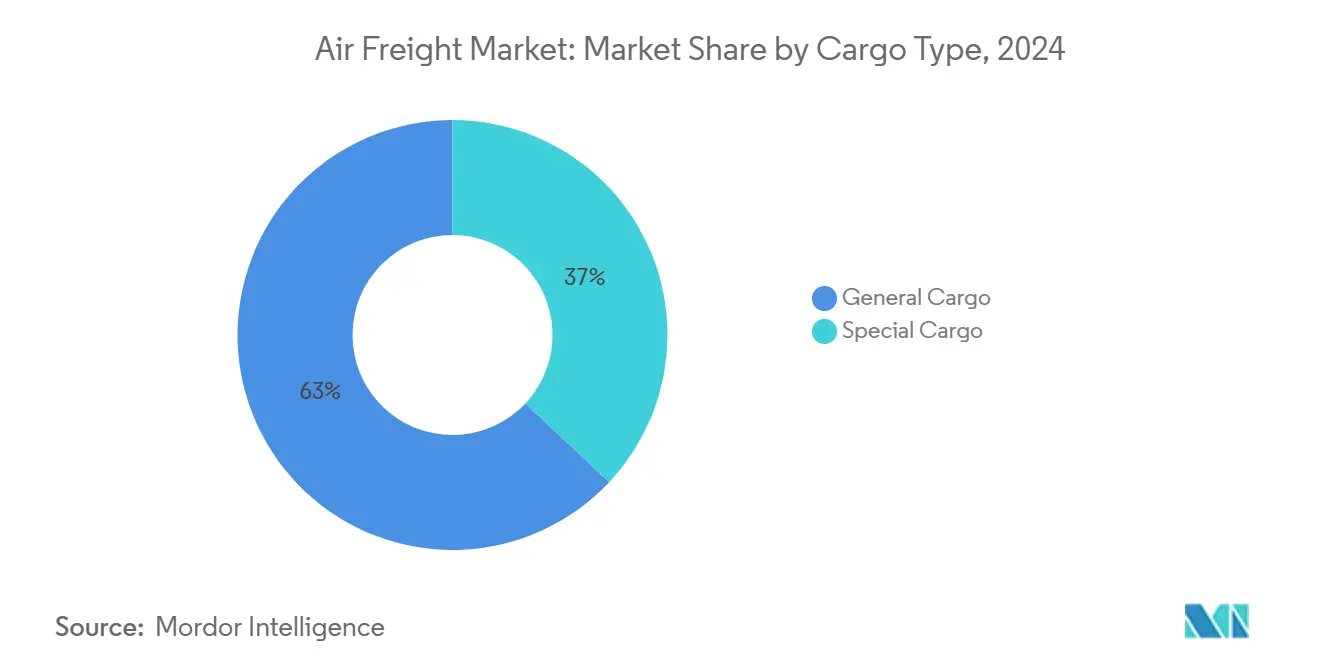
By End-User Industry: Manufacturing Leadership and E-Commerce Surge
Manufacturing & Automotive sustained a 29% revenue share in 2024 due to just-in-time parts flows and high downtime penalties. Carmakers rely on expedited air bridges for critical components during supply disruptions, ensuring assembly-line continuity. E-commerce & Retail exhibits the quickest 5.30% CAGR on the back of direct-to-consumer shipping models that prioritize transit speed over cost. Retailers integrate cross-border air corridors into omnichannel strategies, widening product availability and customer reach.
High-Tech & Electronics, Healthcare & Pharma, and Perishables contribute diversified premium volumes. Each segment demands specialized protocols that deliver above-average yields. Collectively, they enhance cargo mix resilience, stabilizing revenue for operators in the air freight market.
Geography Analysis
Asia-Pacific dominated 2024 with 41% revenue and is expected to post a 5.80% CAGR (2025-2030), reflecting dense manufacturing ecosystems, rapid consumer spending growth, and expanding intra-regional express networks. Strategic hubs in Singapore, Hong Kong, and Incheon interlink secondary production centers, boosting connectivity and network redundancy. Government incentives for near-term capacity growth at Indian and Southeast Asian airports further elevate regional significance.
North America is a significant contributor, supported by resilient domestic parcel demand and Mexico-driven near-shoring. United States regulatory relief on slot usage amid staffing shortages safeguards service continuity at major gateways. Bilateral trade levels underpin balanced CTKs, enhancing structural utilization and supporting the long-term health of the air freight market.
Europe and the Middle East present contrasting outlooks. European carriers face cost pressure from carbon compliance but benefit from a high-value export mix and strong pharmaceutical flows. Middle Eastern hubs exploit geographic proximity among three continents, achieving robust transshipment traffic. Africa and South America remain smaller yet demonstrate opportunity in resource-driven demand and growing e-commerce penetration.
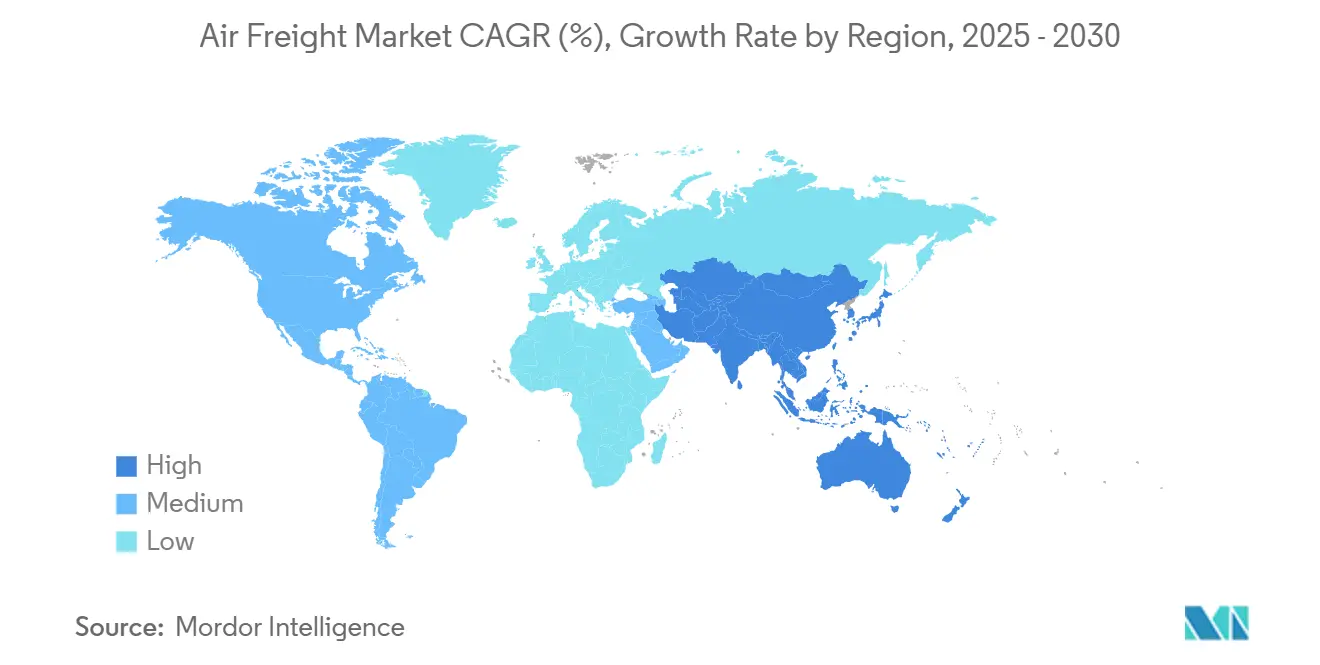
Competitive Landscape
Market concentration is fragmented. FedEx leads cargo CTKs, while Qatar Airways, UPS, and Emirates maintain sizable shares with diversified fleets. DSV’s acquisition of DB Schenker consolidates forwarding power, foreshadowing intensified scale competition. Integrated partnerships such as Air France-KLM and CMA CGM blend air and ocean strengths, offering multimodal solutions that appeal to global shippers.
Technology serves as a key differentiator. Delta trials generative AI pricing; Cathay deploys autonomous ground tractors; Emirates invests in hydrogen-powered trucks to decarbonize first-and-last-mile legs. Labor retention and sustainability investment emerge as strategic priorities. Operators capable of integrating digital platforms, green initiatives, and robust human-capital strategies are best positioned to capture future gains within the air freight market.
Air Freight Industry Leaders
-
FedEx Corporation
-
Emirates SkyCargo
-
Qatar Airways Cargo
-
Delta Cargo
-
Cathay Pacific Cargo
- *Disclaimer: Major Players sorted in no particular order
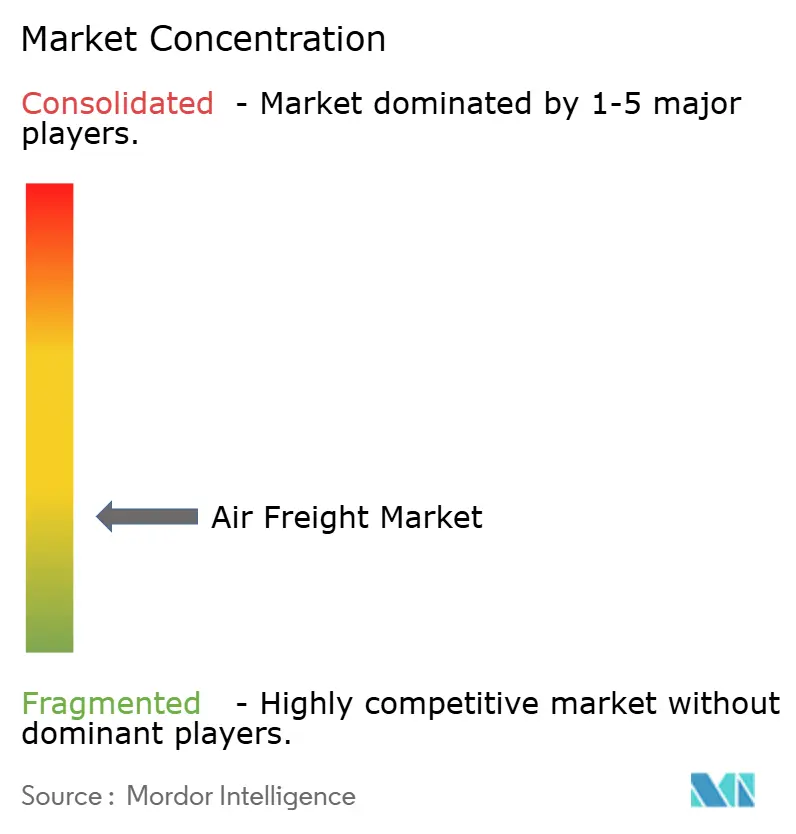
Recent Industry Developments
- July 2025: FedEx introduced a direct Seoul-Taipei service to enhance high-tech trade lane reliability.
- April 2025: Qatar Airways Cargo, IAG Cargo, and MASkargo unveiled a global joint business expected to launch in late 2025.
- April 2025: DSV completed the EUR 14.3 billion (USD 14.9 billion) purchase of DB Schenker, creating the world’s largest forwarder.
- July 2024: Emirates SkyCargo ordered five Boeing 777Fs for delivery in 2025-2026, adding 30% main-deck capacity.
Global Air Freight Market Report Scope
Air freight transport refers to transporting goods by air from one place to another. These services are commonly used for shipments of goods that require quick and effective delivery, particularly over long distances or internationally. Compared to different modes of transport, such as sea or land, air freight has a reputation for speed and reliability.
A detailed analysis of the air cargo market, covering current trends, limitations, and technological advancements, along with comprehensive information on various segments and industry competition, is covered in the report. The impact of COVID-19 has also been incorporated and considered during the study.
The global air freight market is segmented by service (forwarding, airlines, and mail), destination (domestic and international), carrier type (belly cargo and freighter), and geography (Asia-Pacific, North America, Europe, Middle East and Africa, and Latin America). The report offers market size and forecasts for all the above segments in value (USD).
| Freight Transport (Cargo/CEP) |
| Freight Forwarding |
| Other Value-Added Services (Customs brokerage, insurance, etc.) |
| Domestic |
| International |
| Belly Cargo |
| Freighter |
| General Cargo |
| Special Cargo |
| E-commerce & Retail |
| Manufacturing & Automotive |
| Healthcare & Pharmaceuticals |
| Perishables & Fresh Produce |
| High-Tech & Electronics |
| Others |
| North America | United States |
| Canada | |
| Mexico | |
| South America | Brazil |
| Peru | |
| Chile | |
| Argentina | |
| Rest of South America | |
| Asia-Pacific | India |
| China | |
| Japan | |
| Australia | |
| South Korea | |
| South East Asia (Singapore, Malaysia, Thailand, Indonesia, Vietnam, and Philippines) | |
| Rest of Asia-Pacific | |
| Europe | United Kingdom |
| Germany | |
| France | |
| Spain | |
| Italy | |
| BENELUX (Belgium, Netherlands, and Luxembourg) | |
| NORDICS (Denmark, Finland, Iceland, Norway, and Sweden) | |
| Rest of Europe | |
| Middle East and Africa | United Arab of Emirates |
| Saudi Arabia | |
| South Africa | |
| Nigeria | |
| Rest of Middle East And Africa |
| By Service | Freight Transport (Cargo/CEP) | |
| Freight Forwarding | ||
| Other Value-Added Services (Customs brokerage, insurance, etc.) | ||
| By Destination | Domestic | |
| International | ||
| By Carrier Type | Belly Cargo | |
| Freighter | ||
| By Cargo Type | General Cargo | |
| Special Cargo | ||
| By End-User Industry | E-commerce & Retail | |
| Manufacturing & Automotive | ||
| Healthcare & Pharmaceuticals | ||
| Perishables & Fresh Produce | ||
| High-Tech & Electronics | ||
| Others | ||
| By Geography | North America | United States |
| Canada | ||
| Mexico | ||
| South America | Brazil | |
| Peru | ||
| Chile | ||
| Argentina | ||
| Rest of South America | ||
| Asia-Pacific | India | |
| China | ||
| Japan | ||
| Australia | ||
| South Korea | ||
| South East Asia (Singapore, Malaysia, Thailand, Indonesia, Vietnam, and Philippines) | ||
| Rest of Asia-Pacific | ||
| Europe | United Kingdom | |
| Germany | ||
| France | ||
| Spain | ||
| Italy | ||
| BENELUX (Belgium, Netherlands, and Luxembourg) | ||
| NORDICS (Denmark, Finland, Iceland, Norway, and Sweden) | ||
| Rest of Europe | ||
| Middle East and Africa | United Arab of Emirates | |
| Saudi Arabia | ||
| South Africa | ||
| Nigeria | ||
| Rest of Middle East And Africa | ||
Key Questions Answered in the Report
How big is the air freight market in 2025?
The air freight market size stands at USD 160.17 billion in 2025 with a 5.92% CAGR to 2030.
Which region holds the largest share of global air cargo?
Asia-Pacific leads with 41% revenue in 2024 and maintains the fastest 5.80% CAGR through 2030.
What drives the fastest growth within domestic air cargo?
Near-shoring and e-commerce fulfillment boost domestic routes, resulting in a 5.50% CAGR through 2030.
How are carriers coping with stricter emission rules?
Airlines invest in fuel-efficient jets, sustainable aviation fuel, and environmental surcharges to manage compliance costs.
Why are passenger-to-freighter conversions important?
Conversions supply cost-effective capacity tailored to mid-haul e-commerce lanes and are projected to cover over half of future freighter demand.
Page last updated on:
